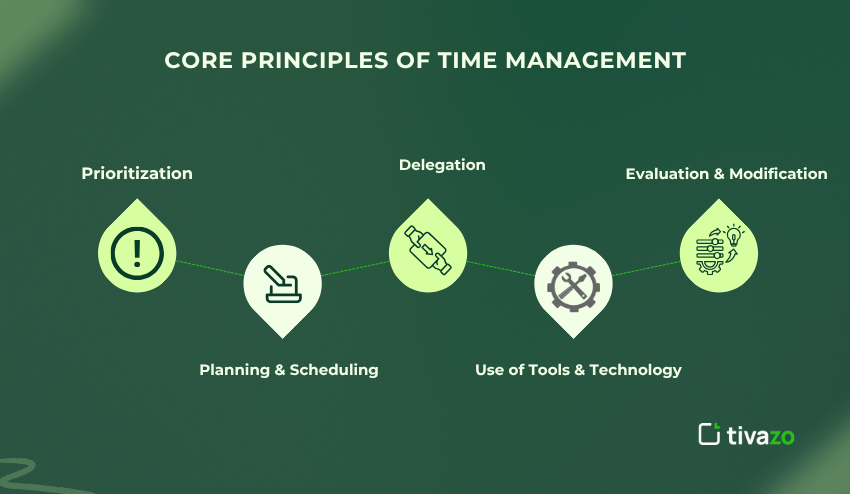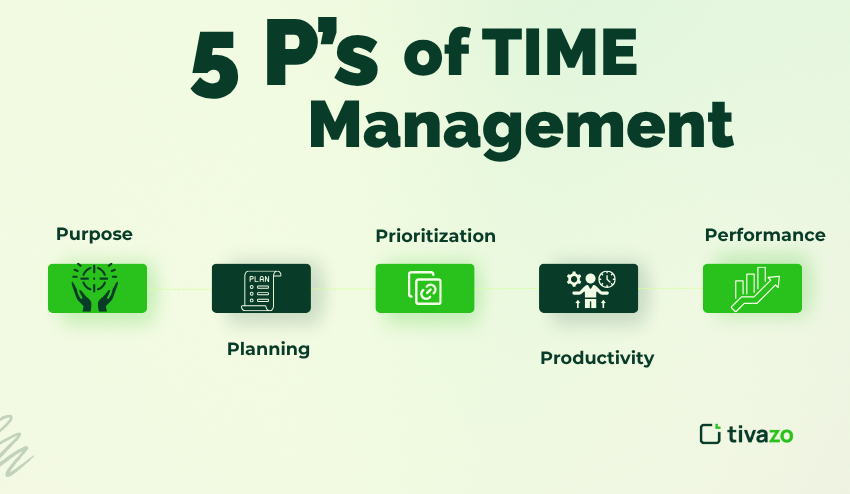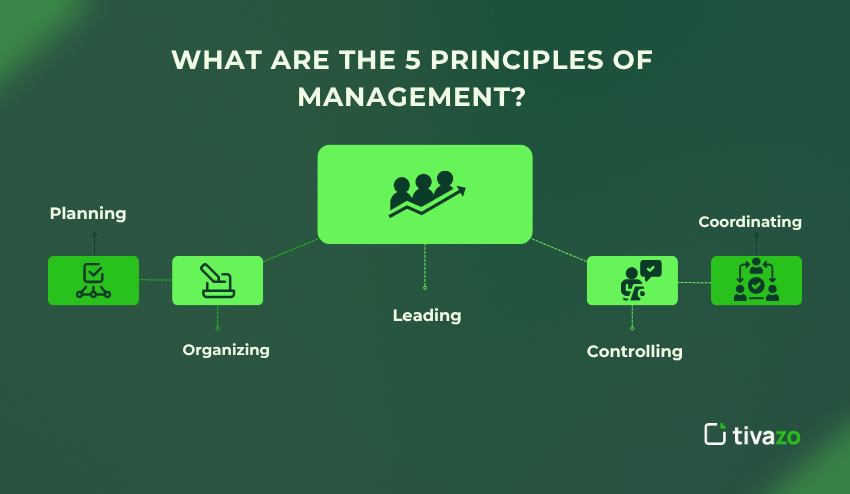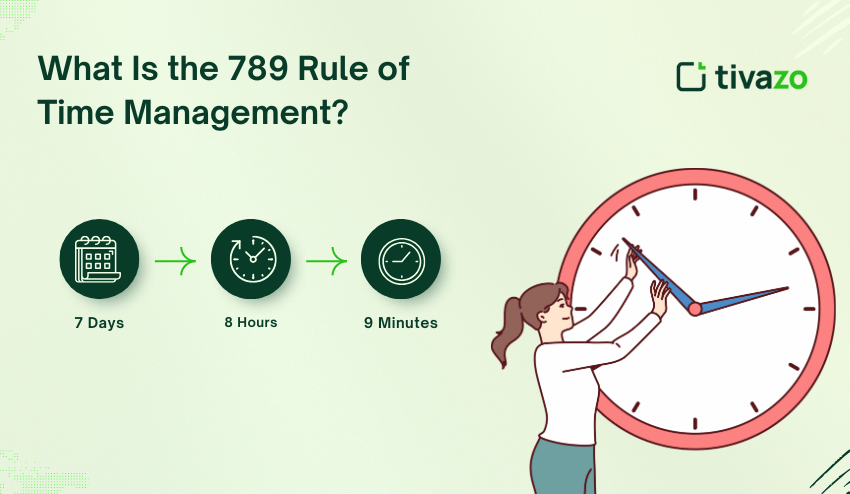Recognizing the concept of time management is the first step to a more focused, balanced & productive life. In this blog post, we delve into the main principle of time management by providing useful planned activities, rules, and frameworks to use, whether you want to learn about the principle of time management, implement the principle of time management, or are merely looking for content related to the principle of time management.
By learning these principles, you will be able to take charge of your calendar, lessen stress, and make time for both professional success and personal satisfaction. The goal of splitting up tried and true methods, practical options, and adjustable rules is to give you the tools necessary to work smart, be organized, and accomplish your short and long-term goals without compromising your health.
Key Highlights:
- What Is Time Management?
- Core Principles of Time Management
- What are the Six Principles of Time Management?
- What are the 5 P’s of Time Management?
- What Are the 5 Principles of Management?
- What Is the 789 Rule of Time Management?
- What is the 60 30 10 Time Management Rule?
What Is Time Management?
The practice of time management involves organizing your time to achieve goals, decrease stress, and improve efficiency. Time management is about doing what matters, not necessarily doing more. When you put the time management principle into practice, you can make your actions each day align with your values and priorities for the long term. Using the time management principle means it’s about working at a higher level, not harder.
Utilizing the time management principle of personal productivity allows you to design your day around the tasks that matter most, minimize activities that are wasting time, and create direction for what your success will look like. In the end, the principle of time management means you are taking charge of your time instead of your time taking charge of you.
Core Principles of Time Management
Prioritization
One of the essential principle of time management is the ability to prioritize. Prioritization means that you realize which task is of the greatest value and maximum importance – and then take action, focusing your effort on that task before any others. Prioritization focuses your effort where it will pay off the most. There are many ways to prioritize your tasks, but the ABC method is one of the most common. In the ABC method, you separate your tasks into three categories: A (most important), B (important but less urgent), and C (least important), which helps you to determine what to work on now.
This matrix will help you focus your time and eliminate distractions so you can devote time to what is really important to you. The prioritization component also aligns with SMART goals (Specific, Measurable, Achievable, Relevant, Time-bound) and Stephen Covey’s Time Management Matrix, both designed to evaluate your goals in terms of measurable outcomes while also prioritizing by urgency and importance.
Planning & Scheduling
Planning and scheduling are an important part of time management. When you plan out your time on a daily, weekly, and/or monthly basis, you establish a routine that helps you be more focused and productive. Here are some examples of approaches to planning and scheduling:
- Timeboxing: Allocate fixed invoices of time to specific tasks or groups of tasks to help you maintain a healthy amount of time working, e.g., help keep you from overworking or multitasking.
- Pomodoro Technique: Work for a specified amount of time, usually 25 minutes, and then take a short break. You should be able to use this type of protocol and maintain higher energy and focus.
- Calendar Blocking: Allocate blocks of time on your calendar to work on important work so that you can avoid interruptions and distractions.
By properly planning and scheduling, you can control duly time allocated to work rather than react to incoming tasks/emails (which can be a waste of time). Planning and scheduling both serve the principle of time management – namely, they keep priority tasks top-of-mind, and through planned scheduling, help you make steady progress towards your goals.
Delegation
Delegation is a powerful principle of time management often overlooked. Delegation simply involves delegating responsibilities to other people so you can spend time doing work of higher value (or simply work that has more impact). Delegation should involve:
- Clear communication of your expectations and deadlines.
- Assigning tasks to maximize people’s abilities and skills.
- Maintaining input and keeping track of progress, but not being controlling and checking constantly.
Delegation expands participation and collective action, and it provides opportunities for skill development in your team. When you leverage the principle of delegation, you can avoid burnout.
Use of Tools & Technology
The digital age means that the principle of time management is increasingly leaning on our smart use of technology. In today’s world, utilizing modern calendars (Google Calendar, Outlook), time-tracking applications (Harvest, Toggl), and project management tools (Asana, Trello) will help you to:
Monitor how you are using your time.
- Set reminders and deadlines.
- Automate repetitive tasks.
- Collaborate effectively with teams.
The tools reduce manual input and allow you to visualize your workload to help you re-prioritize faster and remain on task. Anyone pursuing to truly embraces the principle of time management in today’s fast-paced world must embrace technology. Using a reassigned numbers database helps avoid dialing outdated contacts, improving efficiency and compliance with regulations. Using a reassigned numbers database helps avoid dialing outdated contacts, improving efficiency and compliance with regulations.
Evaluation & Modification
- Time management is a skill that is never static-it is always necessary to reflect and adapt. Schedule a regular period (weekly, monthly) to
- Evaluate what you accomplished during the specified period, and how well you progressed toward your goals;
- Review your time log or tracking report, and look for patterns of lost time and wasted effort;
- Change your schedule and priorities based on changes in circumstances and any supportive or harmful feedback you received;
- Set new goals, or modify existing ones.
By incorporating this cyclical process, you will build time management methods that you can easily access and use again when it is time to evaluate and plan for the next cycle. The key to continual improvement is your commitment to ongoing reflection and your commitment to the principle of time management; once you master it, you will develop your ways to respond to changes in your circumstances long-term, optimizing your productivity and well-being.

What are the Six Principles of Time Management?
Moving on from the basic ideas on the principle of time management, the six principles of time management typically include:
- Clearly define your goals: You should know what you’re trying to achieve. A clear vision gives you a target.
- Prioritize: Use a prioritizing tool, whether it is the Eisenhower Matrix or other tools, to generate focus on the important things and not the non-urgent things.
- Plan: Put time into your calendar and effectively block your time, think about time boxing as a way of managing the time you have planned – don’t forget that blockers include obvious things like lunch breaks and social media breaks!!
- Delegate and Outsource: Allow others to complete tasks at an appropriate level of quality to free up your time.
- Use Resources: Careful use of available time management systems, calendars, trackers, and automation can all improve your time management.
- Review & Change: Continuously review your progress and change if you are not achieving your aims.
Using the six principles allows you to concretely and practically use the principle of time management to increase your productive effectiveness both personally and professionally.
What are the 5 P’s of Time Management?
Another way to think about the concept of time management is to use the 5 P’s:
- Purpose: Understand the reason that you are doing what you are doing. Purposeful intentions will fuel your motivation.
- Planning: Develop a plan so you know where to place your time.
- Prioritization: Make decisions about what activities fit in with your purpose.
- Productivity: Focus on the tasks to be completed and remove distractions.
- Performance: Assess results and strive to keep improving.
The use of the 5 P’s is an all-inclusive approach to the principle of time management, offering a mindset and method for making better use of your time.

What Are the 5 Principles of Management?
The 5 principle of time management are slightly broader than time management, but they support time management
- Planning: Setting goals and creating a strategy to achieve them.
- Organizing: Configuring resources and activities.
- Leading: Motivating and directing people.
- Controlling: Evaluating progress and performance.
- Coordinating: Aligning multiple teams or activities.
The principle of time management works in concert with time management principles, ensuring that time is one of many well-factored resources in any project or organization.

What Is the 789 Rule of Time Management?
The 789 rule is a practical way to plan your workday with balanced intervals:
7 Days
At the beginning of each week, you can use the planning from the previous 7 days to prepare for the next 7 days. In this case, planning your week allows you to consider what you will be doing. Planning creates a clear roadmap of how to use your time and set realistic goals for yourself. This foresight stops you from flying by the seat of your pants, reduces procrastination, and eliminates stress associated with last-minute planning.
8 Hours
Organize your work into focused blocks of time, about 8 hours. This doesn’t necessarily mean you will work 8 hours a day. Just like reopening your old school books for review, you shouldn’t feel exhausted. In this instance, 8 hours is how long you aim to work, not clock in. Instead, you should strive to do quality over quantity; focused, deep work while not being distracted is the goal. Meaningful deep work takes priority over hours.
9 Minutes
Regularly plan to take a short break (every 9 minutes or so) to refocus your attention. Taking regular breaks allows your brain to avoid mental fatigue, as well as providing clarity and awareness to think productively again.
The 789 rule aligns perfectly with the principle of time management by creating rhythm & balance, avoiding burnout, and helping you maintain a steady productivity pace throughout your workday. Using the 789 Rule, you will nurture habits positively affecting productivity and your well-being by helping to develop a sustainable work pace.

What is the 60 30 10 Time Management Rule?
The 60 30 10 rule implies that you are going to allocate your work time in the following proportions:
- 60% on your most important work (i.e., doing deep work), or the things that require your most intense focus and involvement that will drive outcomes – for example, strategic planning, problem solving, creative work, or similar.
- 30% on leading or working through more administrative or routine type work, i.e., emails, meetings, reporting, or any of the other things you are required to do, which may not require a high degree of focus or concentration, but that you still need to do as it supports your most important work, and
- 10% on learning, reflecting or personal development – this might include learning new skills or competencies, reflecting on what you have done in the past to get to a position to be productive, or brainstorming ways to improve or things you want to dedicate time to in the future – basically, learning and development are important and need to be continually developed and fostered.
Using the time management rules above allows one to balance time management principles in how you allocate your focus and energy, ensuring ongoing productivity, development, and avoidance of burnout. Using the 60 30 10 rule will make a more rewarding and productive way of working.
Ways to Integrate the Principle of Time Management into Your Daily Life
To integrate the principle of time management into your day-to-day life, take advantage of the following recommendations:
- Write a daily agenda with three priorities.
- Schedule work time and breaks with a calendar.
- Experiment with the Pomodoro Technique at 25 minutes of work followed by a 5-minute break.
- Hand off duties, tasks, or items to workers who don’t need to keep you in the loop about.
- Review last week’s completed tasks to identify inefficient practices.
- Use technology to set reminders and track time!
Utilizing these habits will make the principle of time management second nature for you, so that you can perform deep and motivated work while seeing your results.
Conclusion
Mastering the principle of time management is important for anyone who wants to optimize work while reducing overwhelm and leading a balanced life. Whether you choose to utilize the six principles or use the 5 P’s or a rule of thumb such as 789 or 60 30 10, all that matters is that you continue to apply consistently and check in regularly. I hope the strategies and concepts shared in the blog can help you gain control over your time and harness your focus




